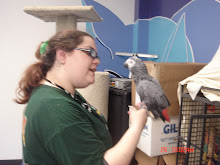It all started when I was taking care of a friend’s male Eclectus, Bayu. He would sneeze on occasion without an obvious reason. He had a clean vet work up and there were no environmental triggers which we could put our fingers on. Because of my parrots and my own chemical sensitivities there are no chemical cleaners or other such allergen or irritant products in my house. When he went back to his home his diet was changed to remove potential allergens such as wheat and soy. But still the sneezing continued. The only thing that seemed to help was having his nares flushed with saline solution, but that only lasted a couple of hours.
Months rolled on and one day a happy coincidence led me to explore further the importance of RH.
It was the first cold snap of the year and I was at home surfing the internet when my Lilac Crowned Amazon, Lucha, sneezed… an hour later he sneezed again, but this time out of the corner of my eye I noticed my digital temperature/hygrometer that I had been using to check my leopard geckos tanks. The temperature was 65 F and the RH was 23%. I then sneezed hard and an idea formed. What if the reason for Bayu, Lucha and myself sneezing was the dry air stimulating our olfactory system?
A couple of days later, warm air moved up from the Gulf of Mexico and fog set in bringing the RH up to 90%. Low and behold both Lucha and I stopped sneezing.
Wanting to confirm my theory with a third case, I took my thermometer/hygrometer to my friend’s house and waited for the next cold front to pass through the state. Sure enough I got a phone call telling me that when the cold front passed, the RH in the room dropped into the thirties and Bayu started sneezing.
Consider the tropics and sub tropics where the majority of parrot species evolved. The average relative humidity is 50% or higher, year round, often with extended periods in the 90s. So it is not surprising that periods of lower humidity can cause problems such as itchy dry skin, increased dust in species which produce it and irritation of the olfactory system. This can also aggravate those who already have related health problems such as birds who pluck and in some cases cause the plucking to start. In our homes we can unknowingly increase the problem by using central heating which dries the air even further. I would encourage all parrot owners to pick up a cheap hygrometer and check the RH of their house, with particular attention to the bird area. I think most owners would be surprised to see it's reading. From there they can take steps to increase the RH to a more suitable number and should note the differences in their birds condition from before and after the changes in RH (a couple of weeks should be given for changes to happen of course, nothing is instant).
Fortunately the solution is simple. Humidifiers can be purchased for a reasonable amount in most home stores. Models range from simple ones with a small tank and an on/off button to larger ones with washable filters, large water tanks and humidistat to turn the machine on and off automatically to keep the RH at a set level.
For those who heat their home through radiators a cheap and easy method is to use the wall radiators to dry wet clothes. As the clothes dry the water that evaporates will raise the humidity in the house.
Since purchasing a humidifier (I went for one with a humidistat) I have kept my house at a constant 55% RH or higher. The change in my birds has been quick and obvious. My Lilac Crowned Amazon has not sneezed in a month; his feet which were getting slightly flakey are smoother and his feathers in better condition. My African Grey is significantly less dusty and is spending less time aggressively preening. As keeping the humidity constant was the only change made during this time, I feel that these improvements in condition are as a result of maintaining a minimum RH of 55%.
Interestingly, since the humidifier was set up near the play scape, on days where the RH is low outside, Lucha will spend most of the day on the part of the play scape closest to the humidifier.
Humidity levels are just as important to feather health as a good soaking bath




Thanks for the observations on humidity. It's something I hadn't really considered, and we are having roller-coaster RH here in southern California too, between fog and rain one week to extremely dry Santa Ana winds the next. Carly can be quite an aggressive preener also, ever since she was a youngster, so I'll definitely start paying attention to humidity.
ReplyDeleteNice blog!
I came to the same conclusion - I received moved from CA to TX where the humidity is near zero, and my African Grey began plucking for, what I thought, no apparent reason... She kept telling me 'shower' several times a day, but thick headed Daddy, didn't get it, until I realized that she was itching herself to death... I got two humidifiers and we have moved from the teens to the 50's and she's not itching or plucking and her feathers are coming back... This is a terribly important feature that all bird owners need to be aware of, especially if they are moving to a new location...
ReplyDelete